November 11 is Martinmas, the feast day of St Martin, or San Martino as he’s known in Italian. I talked about St Martin and his feast day here, and one of the related food products I mentioned was pizza di San Martino. This is a kind of enriched bread – as in Italy, “pizza” doesn’t necessarily imply a thing topped with tomato sauce and cheese. There are many variations on the theme.
Do a Google image search, and pizza di San Martino comes in several forms but they’re all basically yeasted cakes. It probably originates from the small Italian region of Molise, which reaches from the east coast into the Apennines, or possibly from the region to its north, Abruzzo. This area of central Italy, along with Umbria, has suffered recently from a series of earthquakes and aftershocks this year, so making this is one way of saying I’m thinking of friends living there, and anyone who’s lost their homes and livelihoods.
The patron saint of protection against earthquakes is actually Emygdius or Emidio, but he’s pretty obscure and I’m not aware of any baked goods associated with his feast day (5 and 18 August). I’ve adapted this pizza recipe from one found in Cooking with the Saints by Ernst Schuegraf; he doesn’t mention St Emygdius.
As I wrote in my previous piece about St Martin, a traditional pizza di San Martino would contain trinkets, favours, much like the inclusion of a silver coin in traditional British Christmas pudding or ceramic baby Jesus in galette de rois. This recipe doesn’t include any. There’s nothing to stop you adding trinkets though, for luck to whoever receives them.
1. Dissolve the yeast in the warm water.
2. Add about 150g of the strong flour, and blend to form a sponge or pre-ferment.
3. Allow the sponge to develop until it’s nice and bubbly – an hour or two, depending on warmth.
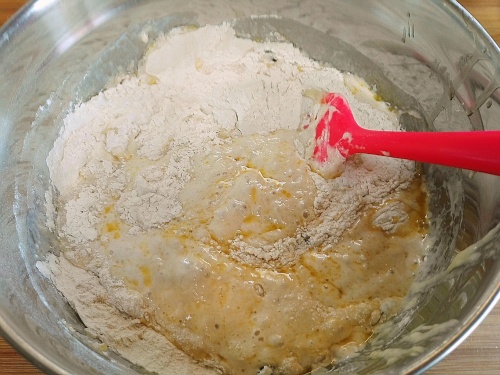
4. Put the rest of the flour and the salt in a large bowl, then pour in the sponge, milk, beaten egg and melted butter and add the sugar, raisins and zest. I used orange and lemon zest.
5. Mix to combine. It’ll be a fairly sticky dough. With just the water and milk, it’s about 67% hydration, but factor in the eggs and melted better too and that’s a fairly high proportion of liquid to flour.
6. Turn out onto an oiled worktop and bring to a dough. For tips on how to handle sticky doughs, read my notes here.
7. Return to the bowl, cleaned and oiled, then cover and leave to prove until doubled in size.
8. Butter a round cake cake tin, ideally 26cm, or even larger. (If you don’t have one, you could bake the pizza freeform, shaped like a disc, on a baking sheet.)
9. Turn out the dough and form into a ball. Push the ball down into the cake tin, then cover and leave to prove again.
10. Preheat the oven to 200C.
11. When the dough is nicely risen, put it in the oven.
12. Bake for about 40 minutes. If it’s browning too much, cover with foil or turn down the oven.
13. Take out, turn out and cool on a rack.
It’s not unlike a kind of brioche, so eat for breakfast, or morning coffee, or with tea. If I’m honest, I’ve no idea how an Italian family would eat it. During my time in Italy I never really managed to inveigle myself into households to watch people eating Easter Colomba or Christmas panettone or other enriched feast day breads like this. So any central Italians reading, please do let me know.

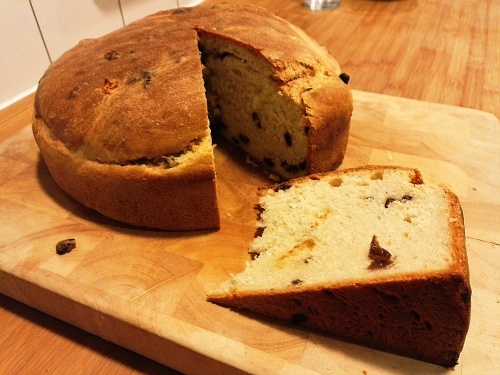
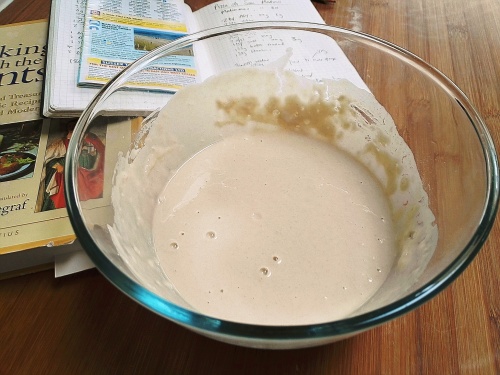
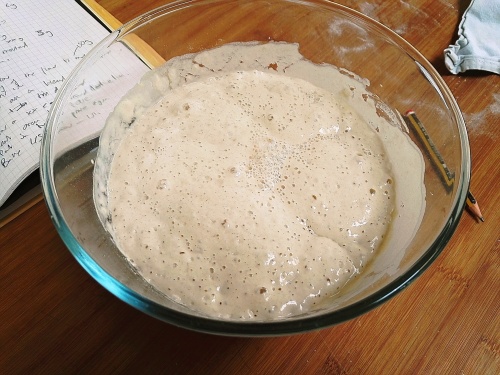
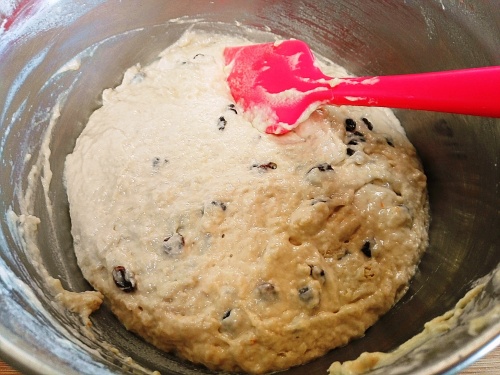
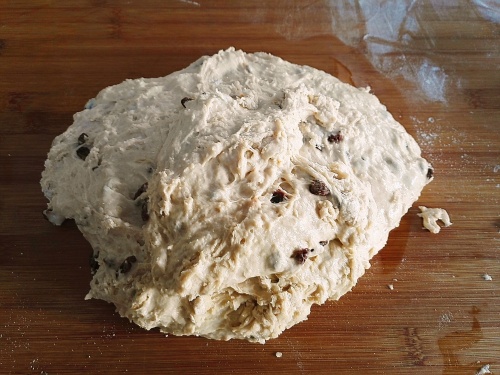
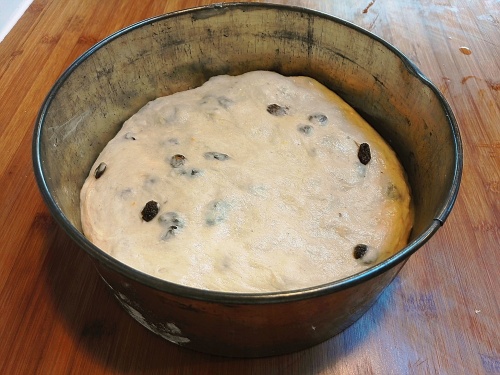

AFAIK there isn’t a clear rule, but I would say that, generally speaking (in the North, at least, but I’m pretty sure it’s very similar everywhere in Italy) we usually eat “proper” (as in artisan-made/super-expensive) Panettone/Pandoro and Colomba after the Christmas/Easter lunch/dinner, basically as the main “celebratory” dessert (but usually accompanied with other delicious stuff, like Panforte, Torrone or chocolate eggs).
As if we didn’t eat enough during the THREE hours meal.
We also tend to enjoy cheaper, mass produced version of them (but still delicious!) during the few days just before/after the festivity day, as an afternoon tea with colleagues or a 10pm snack with friends, still in a celebratory “best-whishes-exchange” kind of way.
Because it is custom giving/receiving these things as a festive present, we tend to “rack up” a few of them and eat them in the following weeks, during breakfast or as an “addendum” to the meal.
And then they pretty much disappear until the following year.
Never heard of the Pizza di San Martino (although he is the Saint protector of my village!), but I’m going to try it soon (looks yummy), thank you!
Nice blog, BTW! 🙂
Grazie mille Bruno. Nice explanation of Italian feast day indulgences.
This pizza di San Martino – I should point out that I’ve no idea if it’s an “authentic” recipe, but the author of the book I got it from must have based it on… qualcosa. Chi sa?!
I spent over thirty years going to Italy (Brescia) for family celebrations including Christmas and Easter. I spent little time in Italy in the month of November so I don’t have any experience with the feast of St. Martin. Perhaps it is more of a Southern celebration. I’ll see if my relatives can shed any light on San Martino in the North.
As for panettones… A visit to anyone’s home during the holiday season required that a panettone be brought as a hostess gift. I think the same panettone was exchanged among friends several times before it was finally opened and consumed. I once saw a police officer on his pedestal in the one intersection in town directing traffic at midday. At the foot of the pedestal were a bunch of panettones that people had left for him. It was a Kodak moment and I’m sorry I didn’t get a picture of that. Lovely custom. I haven’t seen a traffic officer on a pedestal in eons.
My experience in an Italian household was just as the other poster described: panettone and colomba were eaten as the dessert at the end of the main meal and supplemented with chocolates and pastries from the local pasticceria. I have never seen an Italian eat a slice of either of these for breakfast even though, to my way of thinking, they weren’t quite right for dessert but PERFECT for breakfast. Nope, I had to buy up a zillion of them, box them and bring them back with me on the plane. Then, for weeks after returning home, I could enjoy my panettone or colomba with my morning coffee without the disapproving eye of la mia suocera at the other end of the table.
Fortunately, now panettone and colombas are easily found in the US (in larger metropolitan areas) so I don’t have to buy a ticket to Italy to enjoy these treats!
That’s an excellent description, thanks Janet. Love the idea of the regifting. Ha.
And police officer with his gifts. I still remember seeing cops in the midst of the traffic in Rome, in the chaotic piazza Venezia at the bottom of the Corso, in front of the Il Vittoriano. Didn’t spot any panettone around Xmas though!
And yes, we got quite into the tradition of getting trays of small pastries (mignon) to take to people’s houses as gifts. I really miss those pasticcerie. We had two or three within a 5 minute walk of our apartment. *sigh*